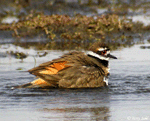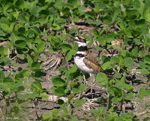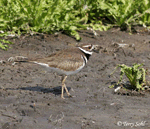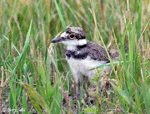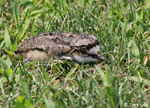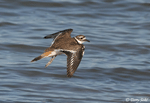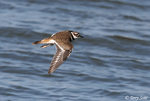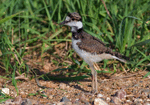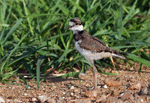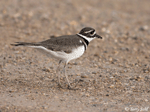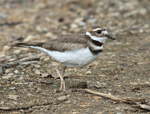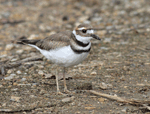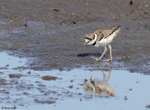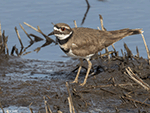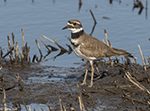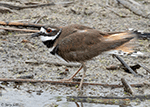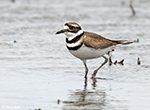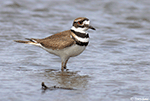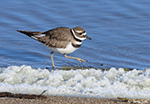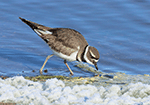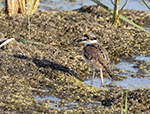Killdeer
Charadrius vociferus
| Length: 9 - 10 inches | Wingspan: 19 - 21 inches | Seasonality: Summer |
| ID Keys: Two black bands across it's chest, red eye ring, distinctive call | ||
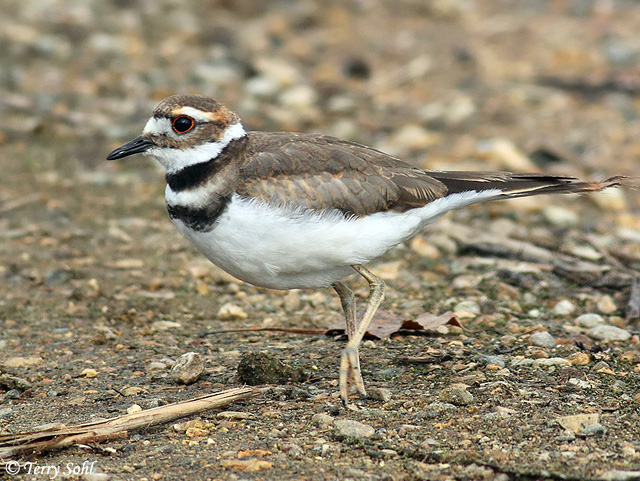 One
of the most common bird sounds heard in South Dakota is the loud kill-deeeer
cry of the Killdeer. They area a very common (and noisy) sight throughout South
Dakota from spring through the fall.. Killdeer are known for the adults' famed "crippled bird" behavior in trying to lure predators
away from their nest by feigning injury. Killdeer have become very
accustomed to a human presence, even nesting in suburban areas where a flat
rock-covered roof or an area of rocky landscaping may serve as a nesting site.
One
of the most common bird sounds heard in South Dakota is the loud kill-deeeer
cry of the Killdeer. They area a very common (and noisy) sight throughout South
Dakota from spring through the fall.. Killdeer are known for the adults' famed "crippled bird" behavior in trying to lure predators
away from their nest by feigning injury. Killdeer have become very
accustomed to a human presence, even nesting in suburban areas where a flat
rock-covered roof or an area of rocky landscaping may serve as a nesting site.
Habitat:
Killdeer can be found in a wide variety of open habitats such as pastures, fields, large lawns, shores, river banks, and mudflats. They do often hang out around shallow water bodies, but are just as at home in a heavily grazed pasture. They avoid areas of tall vegetation, and instead choose barren areas or areas of very low vegetation.
Diet:
Killdeer are opportunistic feeders, feeding on a wide variety of invertebrates and other small prey. That includes many insects and their larvae, earthworms, snails, and crayfish. They have also been known on occasion to feed on waste grain.
Behavior:
Killdeer seem equally at home on the ground or in the air. They're often seen foraging in open fields, mudflats, or shorelines, where they often run several steps, stop and look for food, and then scamper on to the next site. Never one to let an intruder get by without a scolding, they will almost always give their famed kill-deeeer call when a human being approaches, often taking flight and circling to evaluate the threat. They are well known for their broken-wing displays, trying to distract a predator away from an active nest site by faking a severe injury.
Nesting:
May through June in South Dakota. The nest is usually just a simple scraped area on a gravel or sandy area, with bits of rock and vegetation sometimes added after the eggs are laid. Between three and six eggs are laid, with an incubation period of 23 to 27 days. Both parents help to incubate the eggs.
Song:
Killdeer have a number of different vocalizations, from the trademark "kill-deer" cry to piercing calls and more bubbling series of notes.
- Click here to hear the call of a Killdeer1
- Click here to hear the cries of a disturbed Killdeer (alarm calls)2
- Click here to hear the classic two-tone flight call of a Killdeer3
Migration:
Killdeer in the Northern U.S. and Canada migrate to the southern U.S. and Mexico. Southern populations are semi-permanent. In South Dakota, they are often one of the earliest migrants in the spring, sometimes arriving in March when it's still quite cold. They also can sometimes stay rather late into the fall.
Interactive eBird Map:
Click here to access an interactive eBird map of Killdeeer sightings
Similar Species:
We have multiple plover species that can appear in South Dakota, with brownish backs, white underparts, and various neck band patterns. Here are the species most likely to be confused with a Killdeer:
- Semipalmated Plover - Semipalmated Plovers are uncommon migrants in South Dakota, and are a species that may often cross paths with a Killdeer during migration. They are also the species most likely to be confused with a Killdeer in the state, given the similar plumage pattern. Size differences are obvious, however, as Semipalmated Plovers are substantially smaller than Killdeers. The trademark call of the Killdeer is also a clue. Semipalmated Plovers also have a smaller bill than a Killdeer, just one black band around their neck, and black banding on the head.
- Piping Plover - Piping plover are another "banded" plover species found in the state. They are typically restricted to the Missouri River area and tributaries, where they breed on extensive sandy areas. Piping Plover are smaller than Killdeer, noticeably paler, and only have one partial black neck band.
- Snowy Plover - Snowy Plover are a rare sight in South Dakota, although since the mid-2000s, there have been multiple confirmed breeding attempts in the state. They are noticeably paler than a Killdeer, have only a single, partial black neck band, and have a black smudge behind the eye that's absent on a Killdeer.
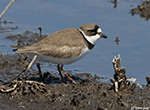 |
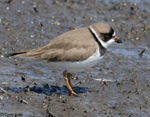 |
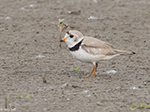 |
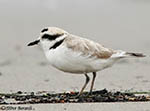 |
| Semipalmated Plover | Semipalmated Plover | Piping Plover | Snowy Plover |
Conservation Status:
Widespread and common, and becoming well adapted to living in a human presence. Nesting often occurs in and around suburban settings now, with birds even adapting to nest on a rock roof or in suburban rock landscaping. The IUCN considers the Killdeer to be a species of "Least Concern".
Further Information:
Photo Information:
August 13th, 2011 - Western Minnehaha County -- Terry Sohl
Additional Photos:
Click on the image chips or text links below for additional, higher-resolution Killdeer photos.
Audio File Credits:
- 1Antonio Xeira. Recorded in Macomb County, Michigan on September 23rd, 2015. Original file and information from xeno-canto.
- 2Hans Matheve. Recorded in Cuba on April 20th, 2015. Original file and information from xeno-canto.
- 3Martin St-Michel. Recorded in Quebec on October 5th, 2013. Original file and information from xeno-canto.
| Click on the map below for a higher-resolution view |
 |
| South Dakota Status: Common and widespread throughout South Dakota |
Additional Killdeer Photos
Click for a higher-resolution version of these photos
